Rutting is one of the main distresses in asphalt pavements.As the traffic load repetitions increase, rutting will gradually appear and deepen[1-2].Compared with cracks and water damage, rutting distress occurs not only on the road surface but also on different structure layers[3-5].Moreover, when a vehicle turns or changes lanes, the stability of vehicle handling is directly affected.When water accumulates inside ruts during a rainy day, passing vehicles are prone to drifting, which threatens traffic safety and is extremely harmful[6-8].Furthermore, asphalt pavement rutting is mainly caused by the flow deformation of the asphalt layer under the composite effects of high temperature and traffic load.The causes of its formation are much more complicated, which brings greater difficulty in conducting research regarding rutting influencing factors[9].Hence, finding an effective research method and clarifying the influence degree of each factor is essential for the prediction and prevention of rutting distress.
Any field of asphalt pavement research, including the research regarding rutting influencing factors, cannot be performed without relevant test data as the research basis.The research regarding rutting influencing factors requires the mining and analysis of multiple service data of asphalt pavements.Hence, accurate and reliable test data are needed as the research basis.For the research on asphalt pavements, data sources generally include laboratory experiments, accelerated loading tests, and long-term pavement performance tracking.The laboratory experiment method is a simulation of the actual pavement state.However, a certain gap exists between the obtained data and the actual pavement service state[10].Although long-term pavement performance tracking can best reflect the real service status, there are still some disadvantages, such as poor quality of the obtained data, high life cycle cost, and long loading cycle[11-12].Compared with laboratory experiments and long-term pavement performance tracking, accelerated loading tests can not only reflect the real service status of pavement more realistically but also provide road service data in a short time[13-14].A full-scale track, called RIOHTrack, was built in Beijing, China.The RIOH is the abbreviation of the Ministry of Transport Research Institute of Highway.The track is operated by the Ministry of Transport Research Institute of Highway, hence the name RIOHTrack full-scale track.It can reflect the actual service status of asphalt pavements.Relatively complete pavement service performance data with high quality and strong reliability are collected[15].With the rapid development of sensor acquisition technology and data storage technology[16-17], the full-scale track integrates a large amount of measured data, including environmental data, material test data, mechanical response, and pavement service data[18-19].It provides a solid and reliable data platform foundation for the research on rutting influencing factors.
In addition, although many studies have been performed on rutting influencing factors, they are all based on the perspective of individual factors to predict rutting.Accordingly, the consideration is more one-sided and lacks effective means for factor screening and data processing[20-21].Moreover, effective screening methods and data processing methods are crucial to the accurate estimation and prevention of rutting distress.With the development of statistical technology and big data algorithm technology, rutting data and their influencing factors can be analyzed through statistical methods[22-23].However, whether there are common influencing factors among the rutting influencing factors and whether the variables with the same characteristic can be transformed into the expression of the same influencing factor remain to be clarified.Thus, it is of great necessity to explore the common internal factors of the selected rutting influencing factors.
In this study, the database of the RIOHTrack full-scale track was first collected, and the data of rutting deformation and their influencing factors were analyzed.Then, the influencing factors of the rutting deformation were determined based on the data analysis.Finally, taking the standard test pavement structure of RIOHTrack as an example, statistical software was employed to investigate the common influencing factors based on FAM in data mining technology.In this way, the main rutting influencing factors were selected, and a screening method for rutting prediction was established.Corresponding maintenance strategies can be made with the aid of the main influencing factors and the rutting prediction method.Hence, the determination of main influencing factors and prediction method are of great significance to the prediction and prevention of rutting distress.
1 Factor Analysis Method
1.1 Concept of factor analysis method
The factor analysis method(FAM)is a technical means to reduce dimensionality and simplify data.It utilizes a few abstract variables to represent its basic data structure by examining internal dependencies among many variables.These abstract variables are called factors and can reflect the main information of numerous original variables.The original variables are observable current variables, while factors are generally unobservable latent variables[24-25].This statistical method of multivariate data processing can reveal the relationship among multiple variables.It summarizes a few factors from many observable variables and then uses fewer factor variables to explain the original observation information to the greatest extent.Therefore, a simple conceptual system was established in this study to reveal the essential connections among objectives.There are two types of factor analysis, namely, confirmatory factor analysis and exploratory factor analysis.Confirmatory factor analysis requires clear information about the characteristics of variables and the relationship between them before testing.However, exploratory factor analysis does not need these conditions.Because the relationship among rutting influencing factors is unclear, this study adopts exploratory FAM to explore the internal relationships among rutting influencing factors.
1.2 Principle model of factor analysis
Factor analysis extracts common factors from the variable group and classifies variables of the same characteristics into one factor, which is used to describe basic hidden variables[25].The common factors are conjoint influencing factors that cannot be directly observed but objectively exist.They are the representative hidden variables discovered in the original variables and have a close relationship with them.Factor analysis is used to determine the main influencing factor of dependent variables.Each of them can be expressed as the sum of common factors and special factors, that is,
Xi=ai1F1+ai2F2+…+aimFm+εi i=1,2,…,p
(1)
where F1, F2, …, Fm are the common factors; εi is the special factor of Xi; Xi is the measurable variable; and aij is the correlation coefficient between variable Xi and factor Fj(Xi and Fj need to be standardized).aij indicates the degree of dependence of Xi and Fj.The greater the absolute value, the higher the closeness.
The matrix form of the model is as follows:
X=AF+ε
(2)

(3)
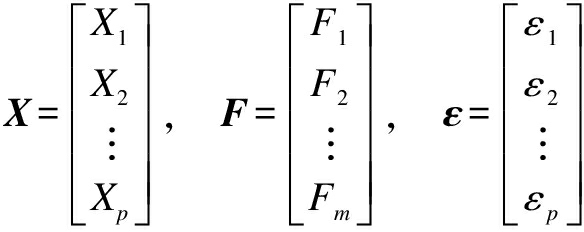
(4)
The above formulas must meet the following requirements.
1)m≤p.
2)Cov(F,ε)=0, which means that common factors and special factors are not related.
3)F matrix was changed to a unit matrix which means that the common factors are uncorrelated and the variance is 1.

4)F matrix was changed to a diagonal matrix. which means that the special factors are not related, and the variances are not required to be equal.
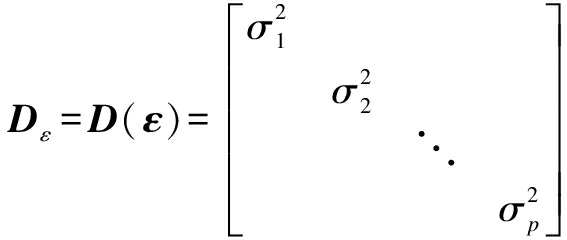
2 Analysis of Rutting Influencing Factors
Rutting is a permanent deformation of asphalt pavements caused by the coupling of traffic load, climate environment, and pavement performance.Its formation is quite complicated.The selected traffic load factors(e.g., axle load and the number of axle load actions)and climate environmental factors(e.g., temperature and humidity)are supposed to be simple to analyze.Meanwhile, many factors need to be considered, such as asphalt penetration, asphalt mixture gradation, asphalt surface layer thickness, and base-layer bearing capacity.The impact indicators are several, and some are difficult to quantify.The previous analysis showed that the influence of these pavement factors on rutting deformation is reflected through the overall bearing capacity of the pavement.The center-point deflection is an important indicator of the mechanical response and the overall bearing capacity of the pavement[26].Hence, we can explore their representativeness as a pavement’s own factors by comparing their correlations with rutting deformation.
To study the main influencing factors of rutting deformation, this study mainly collected the dynamic response data of the pavement performance service data of the RIOHTrack full-scale track.The dynamic response data of the pavement structure mainly includes four parts: load, temperature, humidity, and information on the stress, strain, and displacement in each layer of the pavement.The performance service data of the track mainly includes the pavement bearing capacity and rutting deformation data.Among them, the bearing capacity test is mainly based on the falling weight deflectometer(FWD)test.The FWD test at different service stages adopts the fixed-point test method.The specific test operation refers to the “Highway Subgrade and Pavement Field Inspection Regulations”(JTG E60—2008)[27] and the “Full-Scale Test Loop Inspection Manual”.The inspection frequency was 10 m/point, and an 11 t load was used.Three valid data were collected at each point, and the average value was taken as the center-point deflection value.As for the collection of the rutting depth, a Customer Information Control System multifunctional detection vehicle was employed.The detection frequency is 5 m at every point for the inside and outside wheel paths.The rutting depth was measured in accordance with the distress identification manual used for the RIOHTrack program.A precision of 0.01 mm was employed for the manual measurement of the field rutting depth.
2.1 Traffic load data
RIOHTrack has 19 kinds of designed pavement structures, including flexible base course, semi-rigid base course, and rigid base course.The detailed structure and material information can be found in Ref.[15].The asphalt layer structure STR7 is the representative semi-rigid asphalt pavements adopted in China, with an asphalt layer of 4 cm+6 cm+8 cm(upper, middle, and lower layers, respectively).It is the standard test pavement structure of semi-rigid asphalt pavements and the RIOHTrack full-scale track.The influence of two main traffic load factors, namely, single axle load and the number of axle loads, on the rutting deformation was analyzed based on the relevant service data of the STR7 pavement structure.
2.1.1 Single axle load
The axle load of the loading vehicle was 16 t.However, the axle loads of 10 and 13 t were used for comparison in individual loading cycles to detect the impact of different axle loads on the response of the pavement structure.During the loading period, a certain number of loading repetitions was set.The driving distance was approximately 20 000 km; i.e., approximately 10 000 repetitions of loading are considered a cycle.A regular inspection was conducted to evaluate the impact of different axle loads on the response of the pavement structure.
During the whole year’s loading process, the single axle load was adjusted.Cycles 16 and 17, 24 and 25, 29 and 30, and 35 and 36 are all pairs of loading sub-cycles.The axle load in the previous period was 10 t, while the axle load in the latter period was 13 t.The load mileage of the two sub-periods was approximately 10 000 km.Moreover, different pavement structures were under the same temperature condition.In a word, the difference was just the axle load condition.In this part, based on the rutting deformation data of the STR7 pavement structure, the rutting increments in 51 detection cycles were recorded, as shown in Fig.1.

Fig.1 Rutting increments in 51 detection cycles
In adjacent detection cycles, the environmental conditions were nearly the same.For the rutting deformation of the specific pavement structure, the main difference is the single axle load condition.Fig.1 presents rutting increments after each detection cycle.There is no clear law for the rutting increments after each load cycle.The magnitude of the single axle load is not closely related to the rutting depth.This case may be attributed to the single axle load adopted in the RIOHTrack full-scale track, which is not very large and has little influence on the rutting depth.
2.1.2 Number of axle loads
With the increase in the number of axle loads, the rutting deformation in different pavement structures of the full-scale track steadily developed in the first year of loading.The standard load was set as 100 kN.According to this assumption, the number of axle loads was converted into accumulative equivalent single axle loads(ESALs)based on the index of deflection.The rutting deformation data and loading data of STR7 in the first 12 inspection cycles were selected in this part.Then, a regression analysis of accumulative ESALs and rutting depth was conducted.The curve regression model was RD=aebN(a and b are parameters related to the pavement structure, and N is the accumulative ESALs).The regression curve and results are presented in Fig.2.
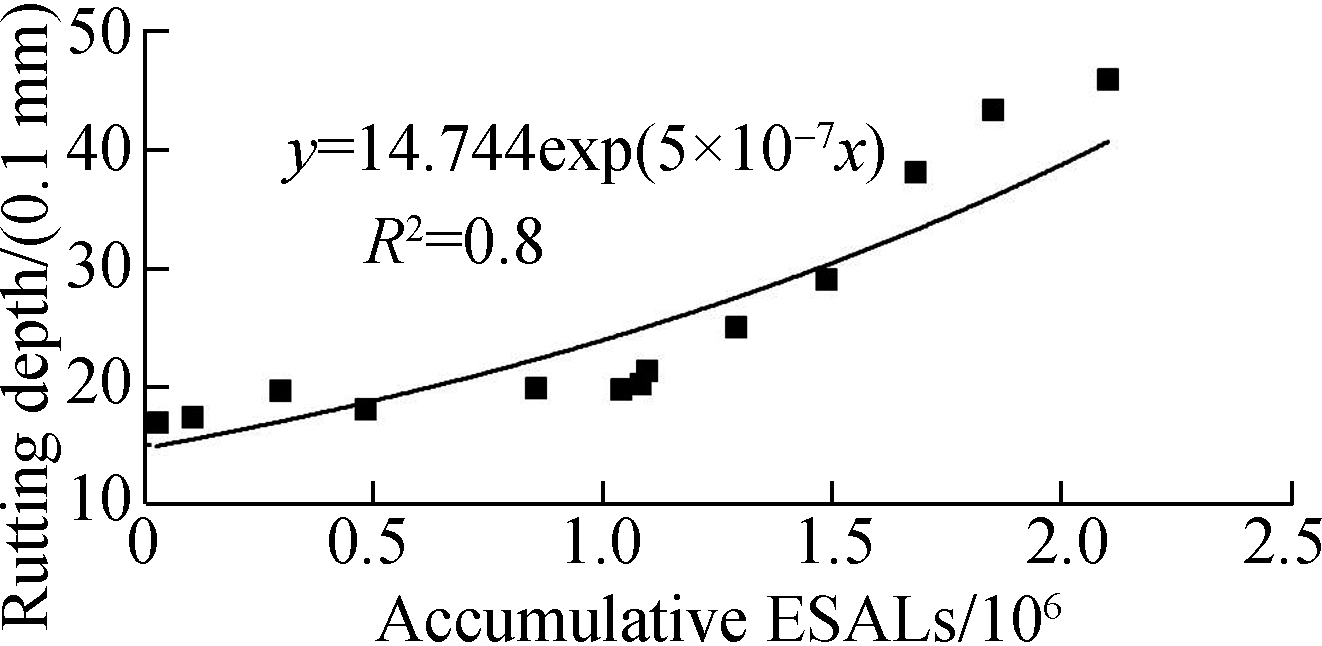
Fig.2 Relationship between accumulative ESALs and rutting depth
Fig.2 shows that the rutting depth exponentially increases with the accumulative ESALs, which can provide a reference for the selection and establishment of the rutting prediction model.
2.2 Environmental data
For the RIOHTrack full-scale track, the main environmental factors that affect rutting deformation are temperature and humidity.The data of these environmental factors are analyzed below.
2.2.1 Environment temperature
Rutting deformation is likely to occur and develop rapidly in hot seasons.Considering unfavorable situations, the average daily maximum temperature during each loading cycle was taken as the representative value of the ambient temperature in this cycle.STR7 is commonly used as a semi-rigid asphalt pavement structure and a standard test pavement structure of the RIOHTrack full-scale track.A regression analysis of the relationship between the rutting depth and ambient temperature was conducted.The regression curve and results are shown in Fig.3.

Fig.3 Regression diagram of the rutting depth with ambient temperature
Fig.3 displays that when the temperature gradually increases, the rutting depth gradually develops, and there is a good exponential correlation between them.
2.2.2 Environmental humidity
Based on the historical weather data of the RIOHTrack full-scale track during the loading period, the average daily relative humidity in each cycle was obtained.In this part, rutting deformation data and environmental humidity data were analyzed.A scatter plot regression analysis between the rutting depth and environmental humidity was conducted.The regression curve and results are shown in Fig.4.When the water source around the road is determined, the environmental humidity depends on the water content of the roadbed and pavement.Because the rutting development law of different pavement structures in the RIOHTrack full-scale track is consistent, STR7 was selected as a representative pavement structure to screen independent variable indicators through factor analysis.The independent variable screening results are representative and applicable to most roads.
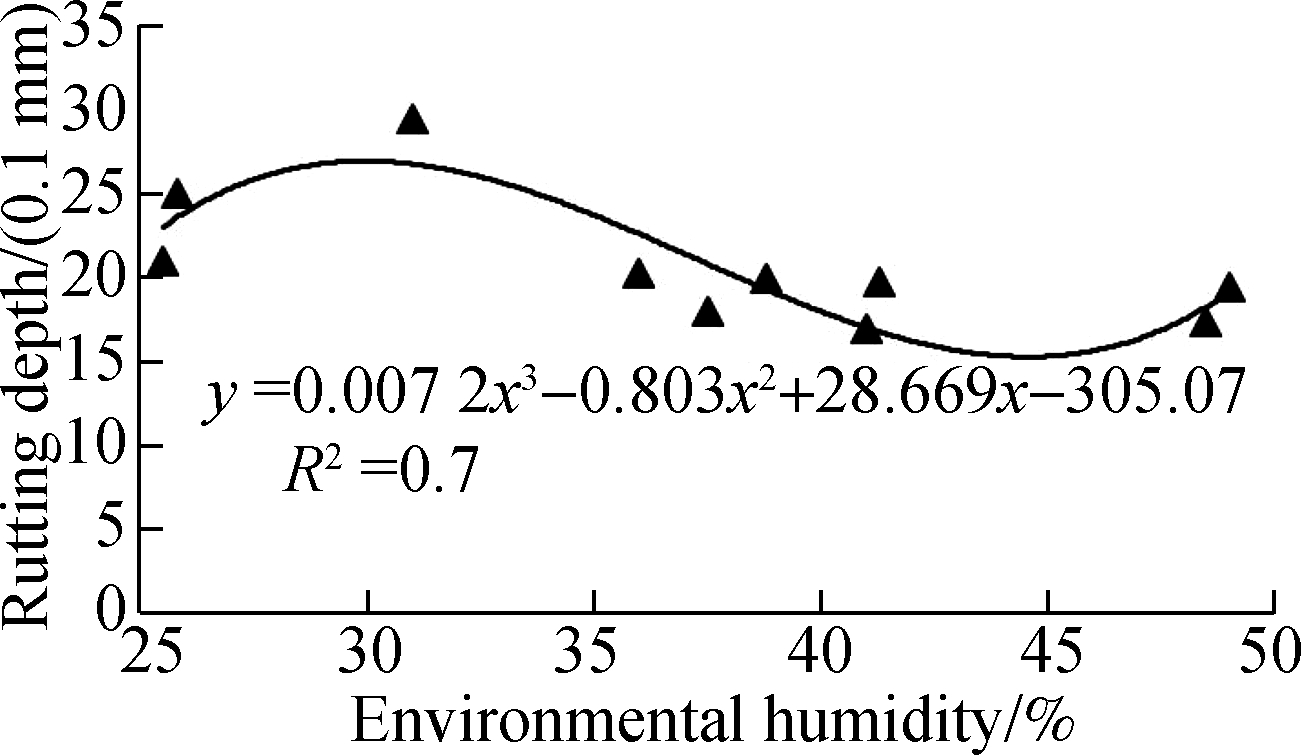
Fig.4 Scatter plot of the rutting depth change with environmental humidity
A certain cubic polynomial relationship exists between the rutting depth and environmental humidity.
2.3 Pavement performance data
The pavement structure and materials have a great influence on the development of rutting deformation.However, it is difficult to quantitatively measure the effect of certain influencing factors on rutting deformation.The center-point deflection is a representative indicator of the pavement structure and material, mechanical response, and pavement bearing capacity.The stress or strain of the pavement material also reflects the pavement performance.Thus, the representativeness of the center-point deflection and stress or strain are compared in this section.
Deflection and stress-strain are two types of indicators for evaluating the pavement structure and material, mechanical response, and pavement bearing capacity.However, the relationship between them is unclear.Wang et al.[18] discovered the relationship between the center-point deflection and vertical stress under different ambient temperature conditions and different asphalt layer depths, as shown in Fig.5(a).The results show that there is a good statistical relationship between the deflection and vertical stress of different asphalt layer depths.Meanwhile, a good statistical relationship was found between deflection and vertical strain.
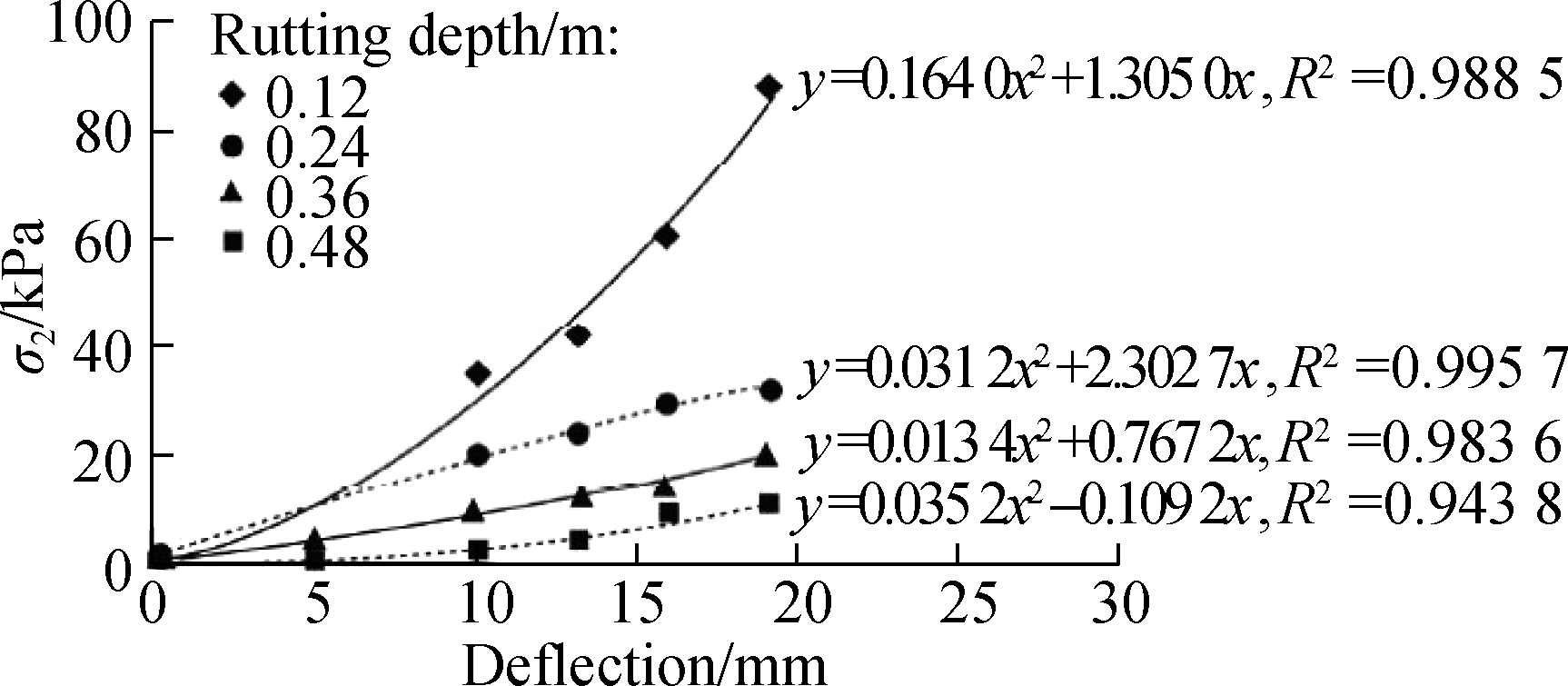
(a)

(b)
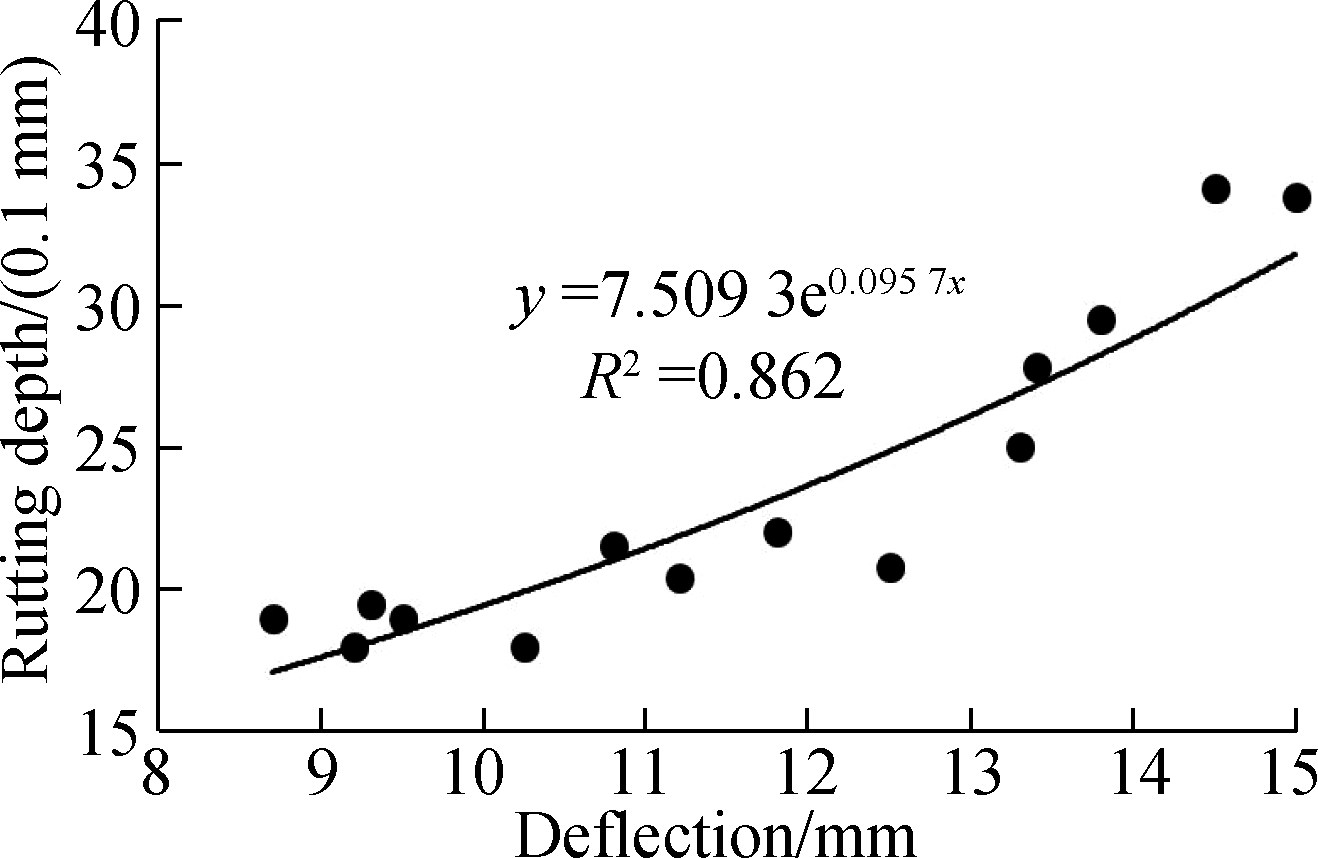
(c)
Fig.5 Relationships among the rutting depth, deflection, and vertical stress.(a)Deflection and vertical stress [18];(b)Rutting depth and vertical stress;(c)Rutting depth and deflection
Deflection and stress-strain are two types of indicators for evaluating the bearing capacity of the pavement structure.Thus, each of them can be selected as an indicator of the pavement structure bearing capacity.Considering the limited test data of the stress and strain at present, the vertical stress at the bottom of the asphalt layer was extracted as an example of the stress or strain.The relationships of the rutting depth with the center-point deflection and vertical stress were analyzed, as shown in Figs.5(b)and(c), respectively.
The regression analysis results in Figs.5(b)and(c)show that the rutting depth correlates well with the center-point deflection but poorly correlates with the vertical stress at the bottom of the asphalt layer.Moreover, compared with the detection of stress or strain of the pavement material, the detection of the center-point deflection can be easily performed.In addition, the center-point deflection represents the overall bearing capacity of the pavement, which can reflect the influence of roadbed conditions on the rutting deformation.The application of the center-point deflection is also beneficial to the use of the established rutting prediction model.Thus, the center-point deflection was selected as a representative indicator of the pavement structure and material performance.In summary, accumulative ESALs, ambient temperature, ambient humidity, and center-point deflection were determined as the influencing factors for the correlation analysis.
3 Results and Discussion
The four variables of the rutting influencing factors were analyzed, and statistical results were obtained, including the descriptive statistics table, Kaiser-Meyer-Olkin(KMO)and Bartlett test table, common factor variance table, explained total variance table, component matrix table, and component score coefficient table.The specific results are shown in Tabs.1 to 5.
Tab.1 Descriptive statistics of the rutting influencing factors

Variable factorAverage valueStandard deviationTemperature23.8011.053Accumulative ESALs1 820 063.291 146 464.93Central point deflection13.083.235Humidity42.1010.531
Tab.2 KMO and Bartlett test

KMO samplingappropriateness numberBartlett sphericity testApproximatechi-squareDegree offreedomSignificance0.5539.8360.000
Tab.3 Common factor variance table

Influencing factorBeginningExtracted value Temperature1.0000.765 Accumulative ESALs1.0000.842 Central deflection1.0000.861 Humidity1.0000.132
Tab.4 Explanation of the total variance

FactorNo.EigenvalueVariancePercentage/%CumulativePercentage/%12.39959.98059.98020.78619.63879.61830.70417.59797.21540.1112.785100.000
In this study, this common factor can be considered a hidden variable, which has a direct correlation with the rutting depth.Thus, the main influencing factors of the dependent variables can be selected using this common factor and can be obtained using the FAM.Because the common factor is a hidden and abstract variable, it cannot be directly used in the prediction model.
The KMO test statistic is an index used to compare the simple correlation coefficients between variables, with a value between 0 and 1.Generally, when the KMO result is greater than 0.5, it can be accepted[28].The KMO value in this study is 0.55, which is considered to be within the acceptable range.Bartlett sphere test is used to test the correlation between the variables in the correlation matrix and whether it is a unit matrix, i.e., whether each variable is independent.If the correlation matrix is a unit matrix, then the variables are independent of each other.The common factors cannot be extracted from it, and factor analysis cannot be applied.The test results show that the significance is far less than 0.05, indicating that the variables are correlated and the factor analysis is effective.
The common factor variance represents the degree to which each variable is represented by the common factor, and the expressed degree can be reflected through the value of the extracted item in Tab.3.The larger the value of extraction, the better the variable can be expressed by the common factor.Generally, a variable greater than 0.5 is considered well expressed.Moreover, a value greater than 0.7 is preferred to indicate that a variable can be expressed reasonably by the common factor.As shown in Tab.3, the extracted values of the ambient temperature, accumulative ESALs, and center-point deflection are all greater than 0.7.The extracted common factor can effectively express the variable.However, the environmental humidity cannot be well expressed by this common factor.
The total variance explanation was used to investigate the contribution rate of the factor to the variable.This variable can be considered as the rutting depth.The minimum quantity of components is needed to express the rutting depth close to 100%.Moreover, three components are needed to explain most information contained in the original variables.
The component matrix is the factor load matrix.The factor load is the correlation coefficient between the variable and common factor.The factor with a larger absolute value of the variable load has a closer relationship with the common factor.The common factor can also better represent this variable.Tab.5 shows that the common factor can well represent the ambient temperature, accumulative ESALs, and center-point deflection, except ambient humidity.However, the component score coefficient of the ambient humidity is very low, and its influence on the common factor can be ignored.Therefore, the final factor score can be obtained through the ambient temperature, accumulative ESALs, and center-point deflection.The score coefficient of each component is multiplied by the respective standardized data.Hence, with an ambient temperature of 0.365, standard axle load number of 0.244, and center-point deflection of 0.387, a hidden new common factor can be synthesized.This common factor is a representative hidden factor that is found out in the three variables.In addition to the environmental humidity, the three rutting influencing factors all have sufficient components to express the common factor to affect the dependent variable of rutting deformation.This finding shows that the three influencing factors have an important impact on rutting deformation, and they can be selected as the independent variable indicators of the rutting prediction model.
Tab.5 Component matrix and score coefficient

IndexFactor loadScore coefficientTemperature0.8750.365Numbers of load0.8840.244Central deflection0.9280.387Humidity0.1580.074
Furthermore, an empirical rutting prediction model was established based on the factor analysis results.The model framework can be depicted through the implicit exponential relationship between the rutting deformation and three influencing factors[18].The model formula can be obtained, as shown in Eq.(1).The database of rutting and three influencing factors were divided into two halves.The first half was utilized for the model regression, and the second half of the database was employed for the model evaluation.The evaluation of the error between the measured values and prediction values is shown in Fig.6.
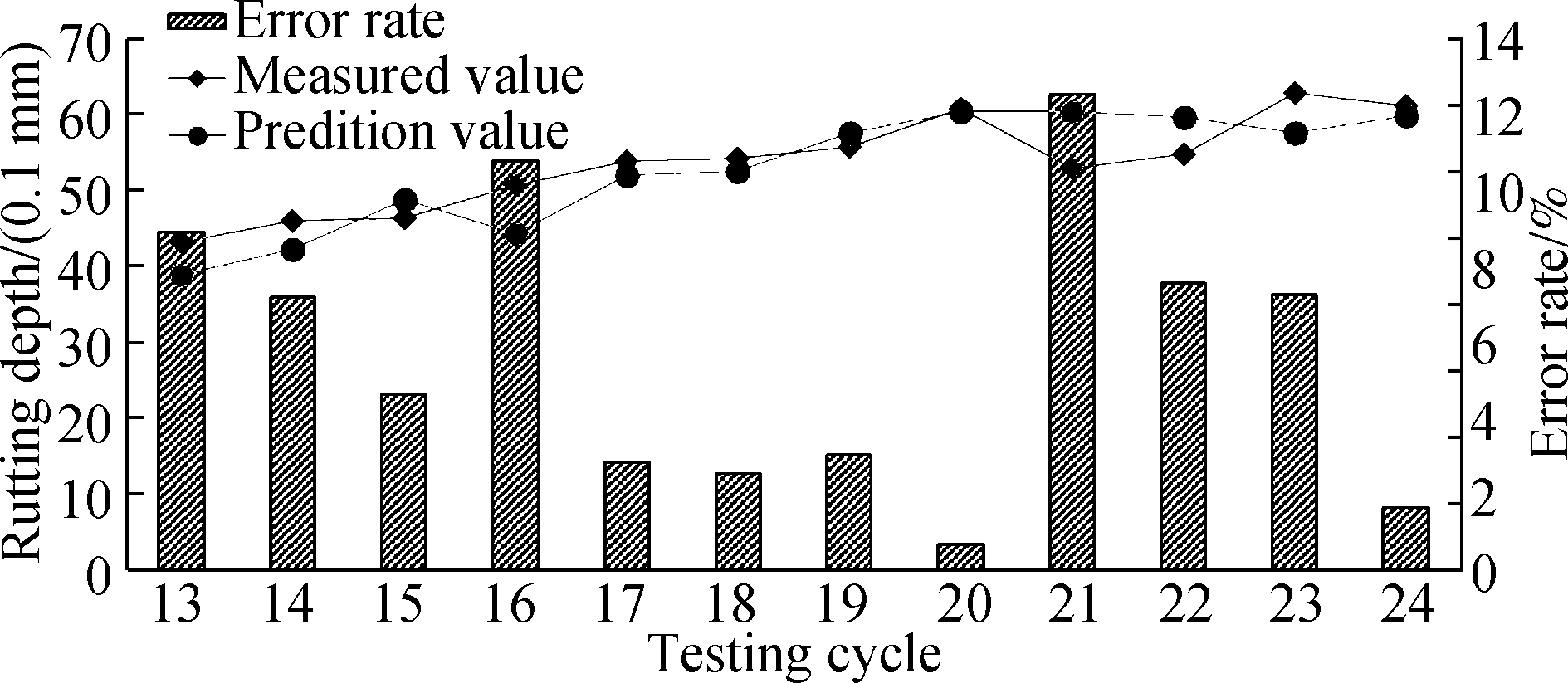
Fig.6 Model prediction results
H=deaTebDecNs
(5)
where H is the rutting depth, 0.1 mm; T is the ambient temperature, ℃; D is the center-point deflection, 0.01 mm; Ns is the accumulative ESALs; and a, b, c, and d are the regression coefficients, with regression values of 7.16×10-3, 1.89×10-2, 4.01×10-7, and 1.05, respectively, obtained through the regression analysis.
Fig.6 shows that the maximum deviation between the predicted values and measured values is not greater than 1 mm.The error rate is less than 15%.Generally, this rutting prediction model is effective and equipped with high prediction accuracy.The prediction results also demonstrate that the selected three rutting influencing factors can determine the development of rutting deformation, and the FAM is an effective way to select rutting prediction model indicators.
4 Conclusions
1)Based on the FAM in data mining technology, the common influencing factors were analyzed.It is found that the accumulative ESALs, ambient temperature, and center-point deflection have an important impact on rutting deformation except for the environmental humidity.
2)The established empirical rutting prediction model is proved to be equipped with a high prediction accuracy, which demonstrates that the FAM is the effective screening method for rutting prediction model indicators.
3)The FAM provides a reference for the selection of independent variable indicators in the rutting prediction model research when used in other areas and is of great significance for the prediction and control of rutting distress.
4)This research is mainly based on data mining and statistical methods.More mechanism analyses of influence factors on rutting deformation need to be conducted based on the follow-up test of the RIOHTrack full-scale track.
[1] Hussan S, Kamal M A, Hafeez I, et al.Modelling asphalt pavement analyzer rut depth using different statistical techniques[J].Road Materials and Pavement Design, 2020, 21(1): 117-142.DOI:10.1080/14680629.2018.1481880.
[2] Yin F, Chen C, West R, et al.Determining the relationship among hamburg wheel-tracking test parameters and correlation to field performance of asphalt pavements[J].Transportation Research Record: Journal of the Transportation Research Board, 2020, 2674(4): 281-291.DOI:10.1177/0361198120912430.
[3] Chen L L, Liu G, Yao B, et al.Rutting prediction model for semirigid base asphalt pavement based on hamburg wheel tracking test[J].International Journal of Geomechanics, 2021, 21(11): 04021215.DOI:10.1061/(asce)gm.1943-5622.0002194.
[4] Lacroix A, Kim Y R.Performance predictions of rutting for the national center for asphalt technology test track[J].Transportation Research Record: Journal of the Transportation Research Board, 2014, 2457(1): 41-50.DOI:10.3141/2457-05.
[5] Syed I A,Mannan U A, Tarefder R A.Comparison of rut performance of asphalt concrete and binder containing warm mix additives[J].International Journal of Pavement Research and Technology, 2019, 12(2): 162-169.DOI:10.1007/s42947-019-0021-4.
[6] Chen L L, Liu G, Qian Z D, et al.Determination of allowable rutting depth based on driving safety analysis[J].Journal of Transportation Engineering, Part B: Pavements, 2020, 146(2): 04020023.DOI:10.1061/jpeodx.0000180.
[7] Li Q, Sun G X, Luo S, et al.Evaluation of rutting and low-temperature cracking resistances of warm-mix recycled asphalt binders under the secondary aging condition[J].Journal of Southeast University(English Edition), 2020, 36(1): 81-87.DOI:10.3969/j.issn.1003-7985.2020.01.011.
[8] Pasindu H R.Methodology for estimation of deduct values for pavement rutting incorporating safety considerations[J].Asian Transport Studies, 2017, 4(4): 715-722.DOI:10.11175/eastsats.4.715.
[9] Yan T, Huang X, Zhang Z, et al.Modification of the linear viscoelastic deformation prediction model of asphalt mixture[J].Journal of Southeast University(English Edition), 2017, 33(1): 86-90.DOI: 10.3969/j.issn.1003-7985.2017.01.014.
[10] Li P.Analysis of influencing factors of full-thick rutting test and prediction of rutting of semi-rigid base asphalt pavement[D].Xi’an: University of Architecture and Technology, 2014.(in Chinese)
[11] Haider S W, Chatti K, Buch N, et al.Statistical analysis of in-service pavement performance data for LTPP SPS-1 and SPS-2 experiments[J].Journal of Transportation Engineering, 2007, 133(6): 378-388.DOI:10.1061/(asce)0733-947x(2007)133: 6(378).
[12] Mamlouk M S, Dosa M.Verification of effectiveness of chip seal as a pavement preventive maintenance treatment using LTPP data[J].International Journal of Pavement Engineering, 2014, 15(10): 879-888.DOI:10.1080/10298436.2014.893318.
[13] Mitchell M R, Link R E,Nazzal M D, et al.Evaluation of warm mix asphalt mixtures containing RAP using accelerated loading tests[J].Journal of Testing and Evaluation, 2011, 39(3): 103158.DOI:10.1520/jte103158.
[14] Fu Q L, Wei J G, Wang L Y.Research on anti-reflection crack performance of OLSM based on MMLS3 equipment[J].China Journal of Highway and Transport, 2020, 33(8): 133-143.DOI: 10.19721/j.cnki.1001-7372.2020.08.014.(in Chinese)
[15] Wang X D.Design of pavement structure and material for full-scale test track[J].Journal of Highway and Transportation Research and Development, 2017, 34(6): 30-37.(in Chinese)
[16] Pan X K.Research on monitoring data mining of asphalt pavement structure information[D].Harbin: Harbin Institute of Technology, 2015.(in Chinese)
[17] Qiu Y Z, Zhai Y B, Geng H Y, et al.Road internal temperature and humidity data acquisition system[J].Electronic Measurement Technology, 2019, 42(4): 14-18.DOI:10.19651/j.cnki.emt.1802200.(in Chinese)
[18] Wang X D, Zhang L, Zhou X Y, et al.Review of researches of RIOHTrack in 2017[J].Journal of Highway and Transportation Research and Development, 2018, 35(4): 1-13.DOI: 10.3969/j.issn.1002-0268.2018.04.001.(in Chinese)
[19] Zhang L, Zhou X Y, Wang X D.Research progress of long-life asphalt pavement behavior based on the RIOHTrack full-scale accelerated loading test[J].Chinese Science Bulletin, 2020, 65(30): 3247-3258.DOI:10.1360/tb-2020-0287.
[20] Walubita L F, Faruk A N M, Zhang J, et al.The hamburg rutting test(HWTT)alternative data analysis methods and HMA screening criteria[J].International Journal of Pavement Research and Technology, 2019, 12(1): 110-116.DOI:10.1007/s42947-019-0014-3.
[21] Guo R, Nian T F, zhou F.Analysis of factors that influence anti-rutting performance of asphalt pavement[J].Construction and Building Materials, 2020, 254: 119237.DOI:10.1016/j.conbuildmat.2020.119237.
[22] Wang J S.Research on preventive maintenance effect of asphalt pavement based on data statistics[D].Nanjing: Southeast University, 2018.(in Chinese)
[23] Xie S W.Application research of mathematical model based on principal component analysis and factor analysis[D].Jinan: Shandong University of Technology, 2016.(in Chinese)
[24] Han B Y.Mathematical model of factor analysis and its development evaluation[J].Science and Technology Information, 2013, 11: 47.DOI: 10.3969/j.issn.1001-9960.2013.11.035.(in Chinese)
[25] Wang J, Ye D Q.Principle and application of multilevel factor analysis model of multiple binary response variables[J].Chinese Journal of Health Statistics, 2008, 25(1): 22-25.(in Chinese)
[26] Wang X D.Discussion on bend deposition index of asphalt pavement[J].Journal of Highway and Transportation Science and Technology, 2015, 32(1): 1-12,24.DOI: 10.3969/j.issn.1002-0268.2015.01.001.(in Chinese)
[27] Ministry of Transport of the People’s Republic of China.Highway subgrade and pavement field inspection regulations: JTG E60—2008[S].Beijing: China Communications Press, 2008.(in Chinese)
[28] Xie K, Zhang J F.Short-term wind speed prediction based on KMO-Bartlett typical wind speed selection[J].Power Equipment, 2017, 31(2): 86-91.DOI: 10.3969/j.issn.1671-086X.2017.02.004.(in Chinese)